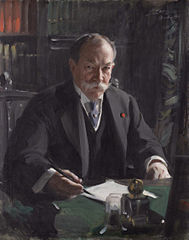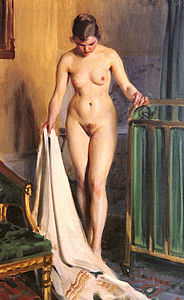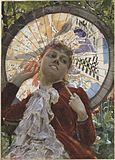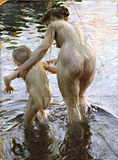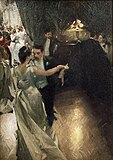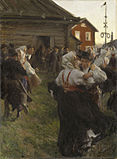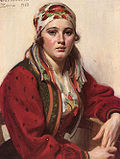Anders Zorn
Anders Zorn | |
|---|---|
Printmaker in etching | |
| Spouse | Emma Lamm |
| Signature | |
 | |




Anders Leonard Zorn (18 February 1860 – 22 August 1920) was a Swedish artist. He attained international success as a painter, sculptor, and
Biography
Zorn was born and raised on his grandparents' farm in Yvraden, a hamlet near the village of Utmeland in the parish of Mora, Dalarna.[3] He studied until the age of twelve in the school at Mora Strand before progressing in the autumn of 1872 to a secondary grammar school in Enköping.
From 1875 to 1880, Zorn studied at the
Zorn traveled extensively, to London, Paris, the
Honors
At the age of 29, he was made a Chevalier de la Légion d'honneur at the Exposition Universelle 1889 Paris World Fair.[5]
- Portrait paintings
-
Mrs. Symons, 1886
-
Lady with fur cape, 1887
-
Mrs. Potter Palmer, 1893
-
Portrait Frieda Schiff, 1894, wife of Felix M. Warburg
-
Mrs. Walter Rathbone Bacon, 1897
-
The King of Sweden, King Oscar II , 1898
-
Mr Henry Clay Pierce,[6] a noted financier and oil industry pioneer, 1899
-
Frances Cleveland, wife of President Grover Cleveland, 1899
-
President Grover Cleveland, 1899
-
The Painter Bruno Liljefors, 1906
-
Hugo Reisinger holding a fashionable grey Homburg hat, 1907
-
The Queen consort of Sweden and Norway, Queen Sophia, 1909
-
William Howard Taft, 27th President of the United States, 1911
-
Ambassador David Jayne Hill, 1911
-
Mme Ashley, 1920
-
Mrs. Eben Richards, 1920
Collection
Zorn's art made him wealthy and he was thus able to build up a considerable collection of art. The objects were not only bought in his native country but also during the many travels he made abroad. In their joint will, Anders and Emma Zorn donated their entire holdings to the Swedish State.
Some of his most important works can be seen at the National Museum of Fine Arts (Swedish:
The Bellman Prize (Bellmanpriset) is a literature prize for "an outstanding Swedish poet", every year awarded by the Swedish Academy. The prize was established by Anders Zorn and his wife Emma in 1920.[7][8]
Zorngården
In 1886, Anders Zorn and his wife, Emma, bought land close to Mora church and here they moved to a cottage from his maternal grandfather's farm. When Anders and Emma Zorn decided to return to Sweden after several years abroad, they began to enlarge the cottage. Zorngården, the Zorn combined smallholding, farmstead, and residence, was completed in 1910.
Zorngården remains today much as it was at the time of Emma Zorn's death in 1942. It is a fine example of an artist's home from the early years of the 20th century. With inspiration from English and Swedish architecture, it is today an excellent example of the architectural freedom that characterizes the years around 1900.

The main part of Zorngården consists of Zorn's home and a museum with his art, but there are two other museums that also are part of the Zorn Collections. Gammelgården is in the southern part of Mora and consists of some 40 timber houses that Zorn bought to make sure that the old art of building such houses would not be forgotten. Gopsmor, Zorn's refuge when under stress, is in the municipality of Älvdalen and is only open for visitors in July.[9]
- Self Portraits
-
Self portrait, undated
-
Self portrait, 1882
-
Self Portrait with Model, 1896
-
Self Portrait with Hat 1907
-
Self Portrait with Fur, 1915
-
Self-portrait in red, 1915
-
Self Portrait with Faun and Nymph (before 1920)
Paintings
While his early works were often brilliant, luminous
- Nudes
-
Freya, 1901
-
Woman bathing at Sandhamn, 1906
-
Skärgårdsblomster (Archipelago flower), 1916
-
Woman in a boat, 1917
-
In the bedroom, 1918
-
Studio Idyll, 1918
The paintings have the freedom and energy of sketches, using warm and cool light and shade areas[1] with contrasting areas of warm and cool tones, and an understanding of color contrasts and reflected lights. Zorn's accomplished use of the brush allows the forms and the texture of the painted subject to reflect and transmit light. In addition to portraits and nudes, Zorn excelled in realistic depictions of water, as well as scenes depicting rustic life and customs.
Zorn's palette
Zorn was known to use a basic color palette consisting of Lead White (Flake White), Yellow Ochre, Vermilion, and Ivory Black. This limited color palette shows tremendous range in terms of color mixing. A large variety of tonal ranges is possible using this palette, a very important development for portrait painting. The color palette can also be used in still life and landscape painting under certain circumstances. The most striking aspect is that an olive greenish color is possible to obtain by mixing Ivory Black with Yellow Ochre, as Ivory Black is bluish in nature.[10]
Other major works
- Martha Dana (later Mrs. William Mercer) (1899) Museum of Fine Arts, Boston[11]
- George Peabody Gardner (1899) Museum of Fine Arts, Boston[12]
- A Portrait of the Daughters of Ramón Subercaseaux (1892), Private collection
- Traveling companion (Mr. Charles Deering) (1904) Museum of Fine Arts, Boston[13]
Works
-
Castles in the Air, 1885
-
Our Daily Bread, 1886, Nationalmuseum, Stockholm
-
Man and boy in Algiers, 1887
-
En premiär, 1888
-
Outdoors, 1888
-
The Tub (1888)
-
Waltz, 1891
-
Omnibus I, 1892
-
An Irish Girl, 1894, National Gallery of Art
-
Midsummer Dance, 1897
-
Dalecarlian Girl Knitting. Cabbage Margit, 1901
-
Hins Anders,fiddler or spelman, 1904 (Thiel Gallery)
-
A Musical Family, 1905
-
Dance in Gopsmor, 1906
-
Girls from Dalarna Having a Bath, 1906
-
Ols Maria, 1918
See also
References
- ^ a b c d e "ART / 4 / 2DAY".
- ^ a b "Anders Zorn: Sweden's Master Painter, National Academy Museum, New York – Review". Financial Times. 17 March 2014. Archived from the original on 2022-12-10. Retrieved 20 October 2022.
- ^ Life of Anders Zorn
- ISBN 978-951-583-557-4.
- ^ "Anders Zorn". Artinthepicture.com. Archived from the original on 2011-07-18.
- ^ Henry Clay Pierce Archived December 25, 2013, at the Wayback Machine
- ^ "Bellmanpriset 2012" [Bellman Prize 2012] (in Swedish). Swedish Academy. Archived from the original on January 16, 2013. Retrieved February 11, 2013.
- ISBN 0-203-32580-X.
- ^ Alsing, Peter (April 22, 2007). "Anders Zorn, the Artist and Collector". Alsing.com.
- ^ Harrison, Birge (1909). Landscape Painting. Scribner. p. 118.
The expert cannot be bothered with useless pigments. He selects the few that are really essential and throws aside the rest as useless lumber. The distinguished Swedish artist, Zorn, uses but two colors—vermilion and yellow ochre; his two other pigments black and white, being the negation of color. With this palette, simple to the point of poverty, he nevertheless finds it possible to paint an immense variety of landscape and figure subjects.
- ^ "MFA Boston: Collections Search Results". Archived from the original on 2007-02-24. Retrieved 2010-01-20.
- ^ "MFA Boston: Collections Search Results". Archived from the original on 2007-02-24. Retrieved 2010-01-20.
- ^ "MFA Boston: Collections Search Results". Archived from the original on 2007-02-24. Retrieved 2010-01-20.
Other sources
- Birnbaum, Britta (1985). Paintings at Nationalmuseum. (Stockholm: Nationalmuseum) ISBN 91-7100-273-1
- Lidbeck, Sven (2007). Anders Zorn Etchings – Catalogue Raisonné 2007. (Stockholm: Zorn Gallery) ISBN 978-91-631-8962-3
- "Anders Zorn in the Gilded Age", Colorado Public Television), one hour, 2013.
- Oliver Tostmann, ed., Anders Zorn: A European Artist Seduces America (Boston: The Isabella Stewart Gardner Museum, 2013)
- ArtGraphica biography
Further reading
- Asplund, Karl. Anders Zorn: His Life And Work (edited By Geoffrey Holme The Studio, Ltd. 1921)
- Facos, Michelle, Swedish Impressionism and Its Boston Champion: Anders Zorn and Mrs. Gardner (Boston: The Isabella Stewart Gardner Museum, 1993)
- Facos, Michelle, “Anders Zorn and English Art,” The Nationalmuseum Bulletin (Spring 1994) vol. 18, no. 1: 58–67
- Laurvik, John Nilsen Anders Zorn (F. Keppel. 1913)
- Engstrom, Albert Anders Zorn (Stockholm: Albert Bonniers Forlag. 1928) Swedish
- Boethius, Gerda Anders Zorn;: An international Swedish artist, his life and work (Stockholm: Nordisk Rotogravyr, 1962) Swedish
- Hagans, William and Willow Zorn In America: A Swedish Impressionist of the Gilded Age (Swedish American Historical Society, 2009) English
External links
- Works by or about Anders Zorn at Internet Archive
- Zorn Collections
- Zorn Gallery in Stockholm
- Works by Anders Zorn at Project Gutenberg
- Listing of 289 Zorn prints with reference numbers and many with images at Artists Archive
- Zorngården house
- Anders Zorn exhibition catalogs
- Anders Zorn: Sweden's Master Painter at National Academy of Design, 2014
- Anders Zorn in the Gilded Age video trailer




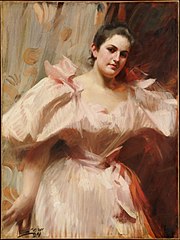


![Mr Henry Clay Pierce,[6] a noted financier and oil industry pioneer, 1899](http://upload.wikimedia.org/wikipedia/commons/thumb/d/d6/Henry_Clay_Pierce_by_Anders_Zorn%2C_1899.jpg/167px-Henry_Clay_Pierce_by_Anders_Zorn%2C_1899.jpg)






